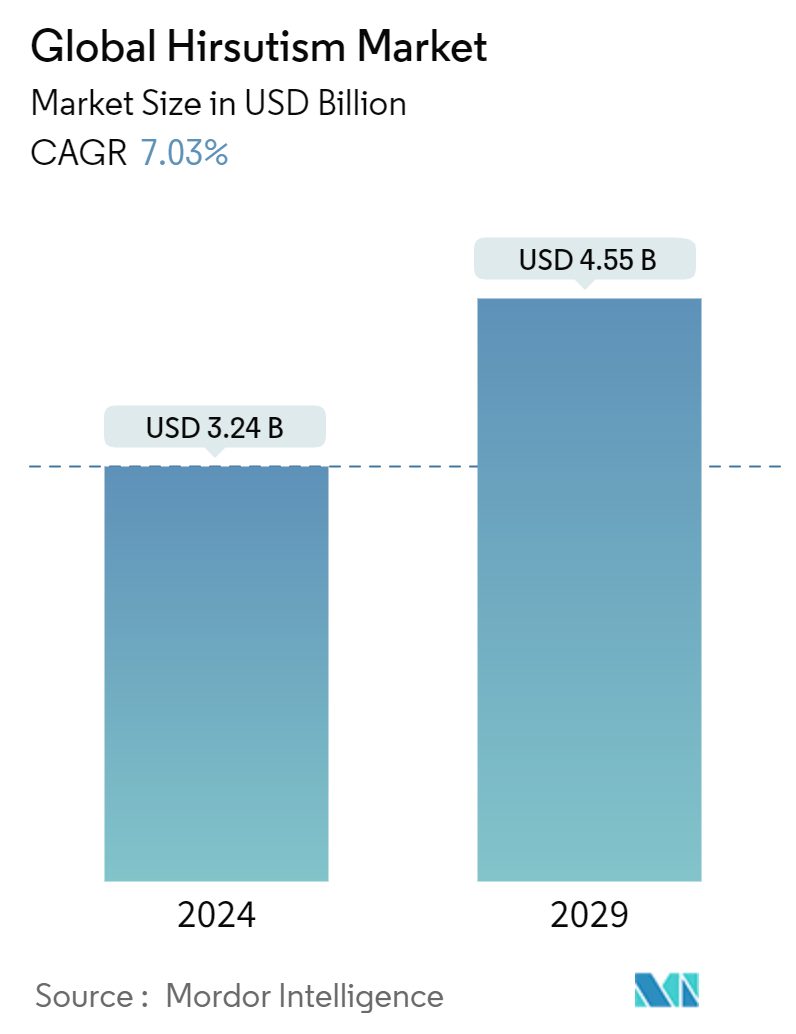Market Size of Global Hirsutism Industry

| Study Period | 2019 - 2029 |
| Market Size (2024) | USD 3.24 Billion |
| Market Size (2029) | USD 4.55 Billion |
| CAGR (2024 - 2029) | 7.03 % |
| Fastest Growing Market | Asia-Pacific |
| Largest Market | North America |
Major Players
*Disclaimer: Major Players sorted in no particular order |
Hirsutism Market Analysis
The Global Hirsutism Market size is estimated at USD 3.24 billion in 2024, and is expected to reach USD 4.55 billion by 2029, growing at a CAGR of 7.03% during the forecast period (2024-2029).
The COVID-19 pandemic moderately impacted the market's growth. The closure of several hospitals and clinics, including hair treatment clinics, led to a decrease in demand for hirsutism products among the patient population. Various studies demonstrated that there was no direct link between hirsutism and COVID-19; thus, patients continued to recommence their treatments amid the outbreak. For instance, as per a study published in the Wiley Public Health Emergency Collection in July 2021, it was observed that the incidence of PCOS, hirsutism, or acne vulgaris in women was not associated with an elevated risk of COVID-19 infection, hospitalization, or mortality. Furthermore, with the lifting of restrictions and the lifting of lockdown measures, the number of people visiting for hair removal treatment has increased. For instance, as per an October 2021 update by DermaCare, cosmetic procedures were expected to rebound to their pre-pandemic levels by October 2021. Thus, the increased patient visits are likely to increase the demand for therapy, which in turn is anticipated to fuel market growth over the forecast period.
Polycystic ovary syndrome (PCOS) is becoming more common, and more people are having problems with their hair, both in terms of how it looks and how it makes them feel.
Body hair is not considered acceptable by numerous cultural and global beauty standards. In every country, facial hair is thought to be unattractive for women. As a result, patients with hirsutism experience increased psychological pressure to adhere to societal expectations of appearance and aesthetics. This is increasing the demand for various hair removal products and options that help get rid of unwanted hair permanently, thereby propelling market growth. For instance, according to an article published in the August 2022 issue of NCBI, some of the causes of hirsutism include the hyperproduction of androgens, whether of ovarian or adrenal origin, and medications such as androgens, glucocorticosteroids, progestins, estrogen antagonists, and others. In addition, as per the same source, the prevalence of hirsutism varies from 10% to 50% among the female population.
Also, a meta-analysis of data published in the June 2022 issue of Human Reproductive found that 26% of people with type 1 diabetes had PCOS.As per the same source, the prevalence of polycystic ovary morphology was 34% in 2021, followed by hyperandrogenemia (29%), hirsutism (24%), and oligomenorrhea (24%). Thus, the high burden of hirsutism among the population is expected to increase the demand for hair removal products and treatment options, which in turn is anticipated to augment market growth over the forecast period.
Also, the growing company's focus on making different products and tools for hair removal is helping the market grow.For instance, in December 2022, Urban Yog launched a painless hair removal spray for women. The spray comes in a foam-based texture and is made with a unique formulation of aloe vera and tulip extracts that leaves the skin supple and removes tan. In addition, in July 2022, Veet will launch Veet Pure, a new dermatologically tested range designed to improve consumers' hair removal experiences. Veet Pure offers a superior, effective, and painless home hair removal treatment by combining natural extracts of cucumber, aloe vera, and grapeseed oil with a recipe that is simplified to meet the changing needs of contemporary women.
Due to things like the growing number of women with polycystic ovary syndrome (PCOS) and the rising number of business activities, it is expected that the market will grow over the next few years. But the high price of laser hair removal is likely to slow the growth of the hirsutism market over the next few years.
Hirsutism Industry Segmentation
As per the scope of this report, hirsutism is referred to as a condition in women that results in excessive growth of dark or coarse hair in a male-like pattern on the face, chest, and back. The hirsutism market is segmented by therapy (procedures and medications), end user (hospitals, clinics, and and geography (North America, Europe, Asia-Pacific, the Middle East and Africa, and South America). The market report also covers the estimated market sizes and trends for 17 different countries across major regions globally. The report offers the value (in USD million) for the above segments.
| By Therapy | |
| Procedures | |
| Medications |
| By End-User | |
| Hospitals | |
| Clinics | |
| Other End-Users |
| Geography | ||||||||
| ||||||||
| ||||||||
| ||||||||
| ||||||||
|
Global Hirsutism Market Size Summary
The hirsutism treatment market is experiencing significant growth, driven by increasing awareness and demand for effective hair removal solutions. The market is characterized by a diverse range of products and procedures, with laser hair removal and intense pulsed light techniques emerging as the fastest-growing segments due to their superior long-term results compared to traditional methods. The rising prevalence of polycystic ovary syndrome (PCOS) and the societal pressures related to body hair are contributing to the market's expansion, as more individuals seek treatments to align with beauty standards. The COVID-19 pandemic initially impacted the market by reducing patient visits to clinics, but demand has rebounded as restrictions have lifted, further fueling market growth.
The Asia-Pacific region is poised for substantial growth, driven by a high incidence of PCOS and increased awareness of advanced hair removal technologies. Countries like Japan, China, India, and South Korea are leading the market due to their high rates of laser hair removal procedures and the growing female population. The introduction of innovative products and technologies, such as the Ulike Sapphire Air Series and Urban Yog's painless hair removal spray, is expected to enhance market dynamics. Despite the high cost of some treatments potentially slowing growth, the market remains competitive with numerous players, including Ajanta Pharma, Cynosure Inc., and Alma Lasers Ltd., actively launching new products and expanding their offerings.
Global Hirsutism Market Size - Table of Contents
-
1. MARKET DYNAMICS
-
1.1 Market Overview
-
1.2 Market Drivers
-
1.2.1 Cosmetic and Psychological Problems Associated with Unwanted Hair
-
1.2.2 Rising Prevalence of Polycystic Ovary Syndrome
-
-
1.3 Market Restraints
-
1.3.1 High Cost of Laser Hair Removal Procedures
-
-
1.4 Porter's Five Forces Analysis
-
1.4.1 Threat of New Entrants
-
1.4.2 Bargaining Power of Buyers/Consumers
-
1.4.3 Bargaining Power of Suppliers
-
1.4.4 Threat of Substitute Products
-
1.4.5 Intensity of Competitive Rivalry
-
-
-
2. MARKET SEGMENTATION (Market Size by Value-USD million)
-
2.1 By Therapy
-
2.1.1 Procedures
-
2.1.2 Medications
-
-
2.2 By End-User
-
2.2.1 Hospitals
-
2.2.2 Clinics
-
2.2.3 Other End-Users
-
-
2.3 Geography
-
2.3.1 North America
-
2.3.1.1 United States
-
2.3.1.2 Canada
-
2.3.1.3 Mexico
-
-
2.3.2 Europe
-
2.3.2.1 Germany
-
2.3.2.2 United Kingdom
-
2.3.2.3 France
-
2.3.2.4 Italy
-
2.3.2.5 Spain
-
2.3.2.6 Rest of Europe
-
-
2.3.3 Asia-Pacific
-
2.3.3.1 China
-
2.3.3.2 Japan
-
2.3.3.3 India
-
2.3.3.4 Australia
-
2.3.3.5 South Korea
-
2.3.3.6 Rest of Asia-Pacific
-
-
2.3.4 Middle East and Africa
-
2.3.4.1 GCC
-
2.3.4.2 South Africa
-
2.3.4.3 Rest of Middle East and Africa
-
-
2.3.5 South America
-
2.3.5.1 Brazil
-
2.3.5.2 Argentina
-
2.3.5.3 Rest of South America
-
-
-
Global Hirsutism Market Size FAQs
How big is the Global Hirsutism Market?
The Global Hirsutism Market size is expected to reach USD 3.24 billion in 2024 and grow at a CAGR of 7.03% to reach USD 4.55 billion by 2029.
What is the current Global Hirsutism Market size?
In 2024, the Global Hirsutism Market size is expected to reach USD 3.24 billion.

